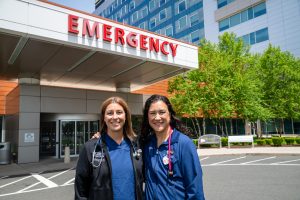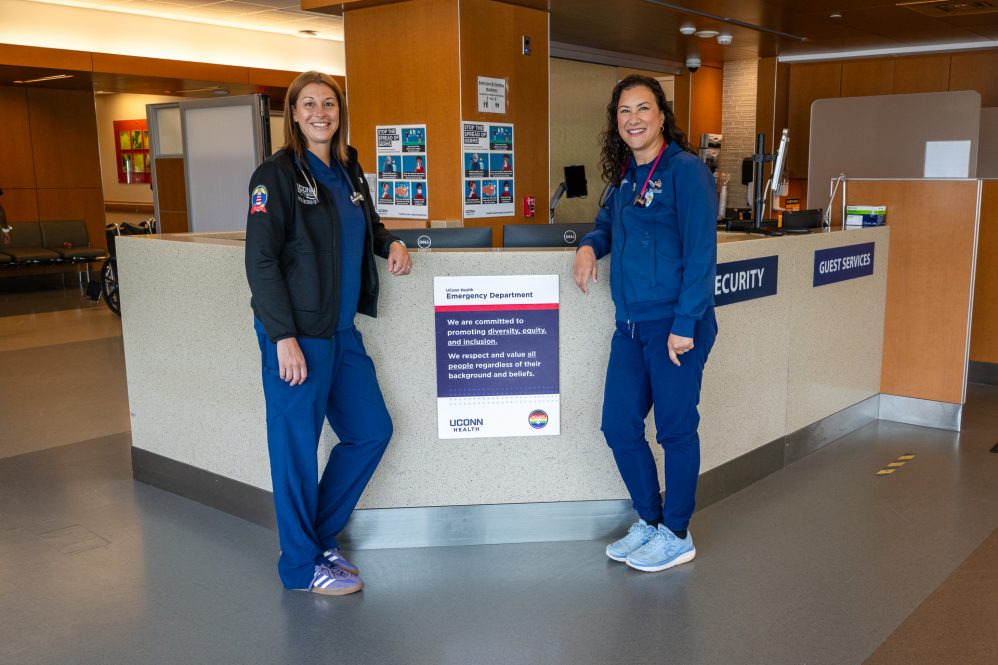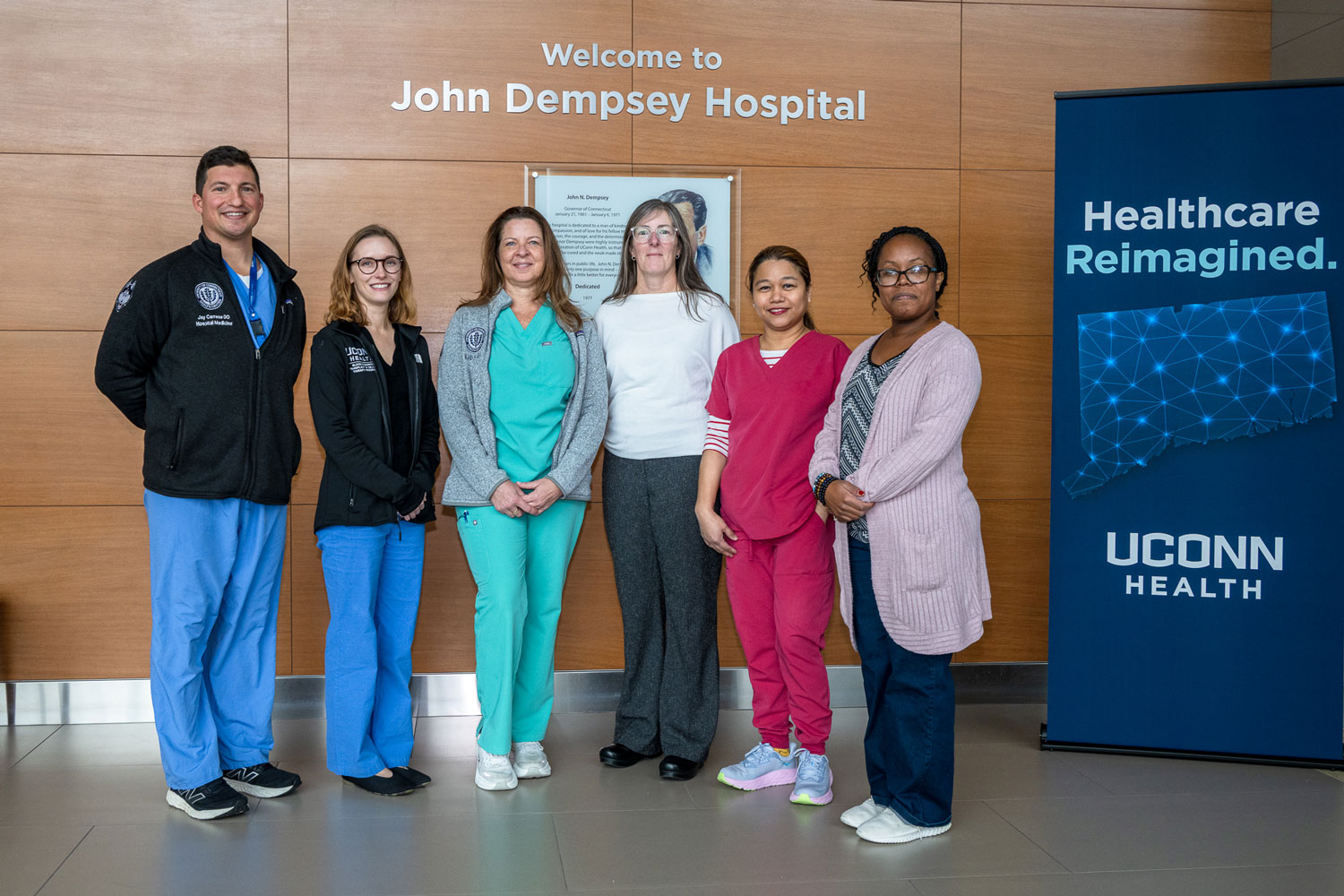In the high-stakes environment of an emergency department where seconds matter and emotions run high, the smallest acts of awareness and compassion can make a life-changing difference, especially for patients from marginalized communities.
That belief has driven two clinicians in the UConn John Dempsey Hospital Emergency Department (ED), Dr. Danielle Mailloux, assistant professor of Emergency Medicine and Dr. Heather Kurtzman, physician assistant, to take action far beyond the scope of their daily roles. Without any formal administrative title or department mandate, they’ve voluntarily launched a series of diversity, equity, and inclusion initiatives that are reshaping how emergency care is delivered and received at UConn Health.
“Our focus has always been on improving the patient experience and quality of care for those who are too often overlooked or underserved,” says Mailloux. “That includes our deaf patients, patients who speak English as a second language, members of the LGBTQ+ community, women, and people of color.”
Centering Care on Women’s Health and Dignity
The initiative began with a focus on women’s health particularly care for patients who have experienced sexual assault. Mailloux and Kurtzman noticed gaps in training, workflow, and equipment that made these already traumatic encounters even harder for patients and providers alike.
In response, they organized educational workshops led by forensic nurse examiners, retraining all ED Physician Assistants and inviting voluntary participation from board-certified emergency physicians. They established a new provider call list for sexual assault exams, created dedicated sexual assault supply bins stocked with essential items, and secured a specialized OB/GYN exam bed for proper pelvic evaluations.
“The old setup was completely inadequate, we were using makeshift props to perform some of the most sensitive exams a patient can go through,” says Kurtzman. “Now we have the right equipment, the right training, and a process that treats patients with the dignity and care they deserve.”
They also worked with UConn Health’s pharmacy team to stock more inclusive emergency contraception options, including medications effective for patients with higher body weight, an important but often overlooked gap in reproductive care. New electronic order sets for sexual health and STD treatment were developed to streamline care for providers, increasing both consistency and timeliness.
Their work didn’t stop at the bedside. A Women’s Health Symposium co-hosted by the Emergency Department, featuring guest speakers and multidisciplinary collaboration with departments such as OB-GYN, is scheduled for later in the month.
Building a More Inclusive Space for All Patients

Mailloux and Kurtzman’s efforts expanded quickly from women’s health to other vulnerable populations. Recognizing ongoing complaints from Deaf patients and their families, they developed a new patient flow to ensure faster, more reliable access to live interpreters. They also created visual cue cards with simple phrases translated into multiple languages to ease communication while patients wait for interpretation services.
“Our interpreters are incredible, but they’re stretched thin,” says Mailloux. “This workflow helps us respect both our patients and our interpreter colleagues, making the experience better for everyone involved.”
To support LGBTQ+ patients, they hosted a powerful panel discussion featuring trans individuals, parents of children who have transitioned, and other community voices. This session helped educate staff about the patient’s perspective and led to real changes. They distributed rainbow badge tags and pronoun stickers for ID badges and advocated successfully for inclusive signage throughout the department.
“Just seeing a flag or a pronoun sticker can mean the world to a patient who’s used to feeling invisible or unsafe in medical settings,” says Kurtzman. “These aren’t just symbols; they’re signals of belonging.”
Small Changes, Big Impact
Many of Mailloux and Kurtzman’s projects focus on small, actionable ways to make the ED feel more compassionate and inclusive. They advocated for a wider range of bandage tones of different skin colors. They assembled comfort kits and clothing for patients who must surrender their garments after an assault. They created QR-code posters in restrooms linking discreetly to resources for addiction recovery, human trafficking, and domestic violence, offering a safe and private way for patients to ask for help.
They’ve also collaborated with UConn Health’s addiction services and the Connecticut Community for Addiction Recovery (CCAR) to host educational sessions about stigma, harm reduction, and recovery bringing in speakers with lived experience, including CCAR leaders and community-based police officers from a local human trafficking task force.
“We try to combine education with action,” Kurtzman explains. “That way, we’re not just learning we’re changing the environment to reflect those lessons.”
A Grassroots Movement That’s Gaining Momentum
While their work began informally, word has spread. Educational sessions are now open to staff across UConn Health, and participation continues to grow. Their recent Winter Donation Drive for Hartford’s House of Bread marked the Emergency Department’s first coordinated community outreach effort a milestone they hope to build on with more events.
“This work has really lit a fire under us,” Mailloux says. “We’re just people who care deeply about our patients and our colleagues and we’ve realized we actually can make changes that matter.”
“This is our passion project,” says Kurtzman. “It’s voluntary. We do it on our own time. But we believe that everyone who walks into our ED deserves to feel safe, respected, and seen. And that belief is what keeps us going.”
Mailloux and Kurtzman’s work has already changed the Emergency Department in tangible, visible ways, but their mission is far from over.
“We’ve seen how small changes can lead to big improvements,” says Mailloux. “Now we’re asking bigger questions, too.”
One of those questions involves the use of hallway beds, a frequent source of frustration among patients and a growing concern in emergency care settings across the country. Mailloux and Kurtzman have begun researching the demographics of patients placed in hallway beds to explore whether any racial, ethnic, or systemic disparities exist in those decisions.
“It’s about making sure that unconscious bias isn’t playing a role in who gets full room placement and who doesn’t,” says Kurtzman. “We want to make sure every decision we make is rooted in fairness, medical urgency, and equity, not assumption.”
At the same time, they’re rolling out a new educational initiative in the ED’s waiting area: informational slides on TV screens that explain how the Emergency Department works, what patients should expect, and why someone else may be seen before them. The slides will also address common concerns about hallway beds, providing honest, compassionate explanations about how those decisions are made and why it may lead to faster care.
“We want patients to feel informed and empowered,” says Mailloux.
Mailloux and Kurtzman know that not every problem can be solved overnight. But their work proves that with a clear purpose, grassroots leadership, and an unwavering commitment to equity, even a busy Emergency Department can become a more inclusive, compassionate, and responsive place to receive care.
“It’s been pretty cool,” says Mailloux. “Patients are noticing. Colleagues are noticing. And we’re just grateful to be part of something that’s working and evolving.”



